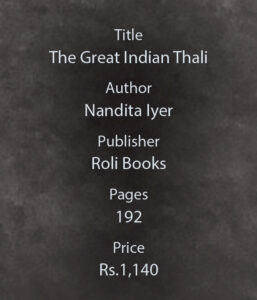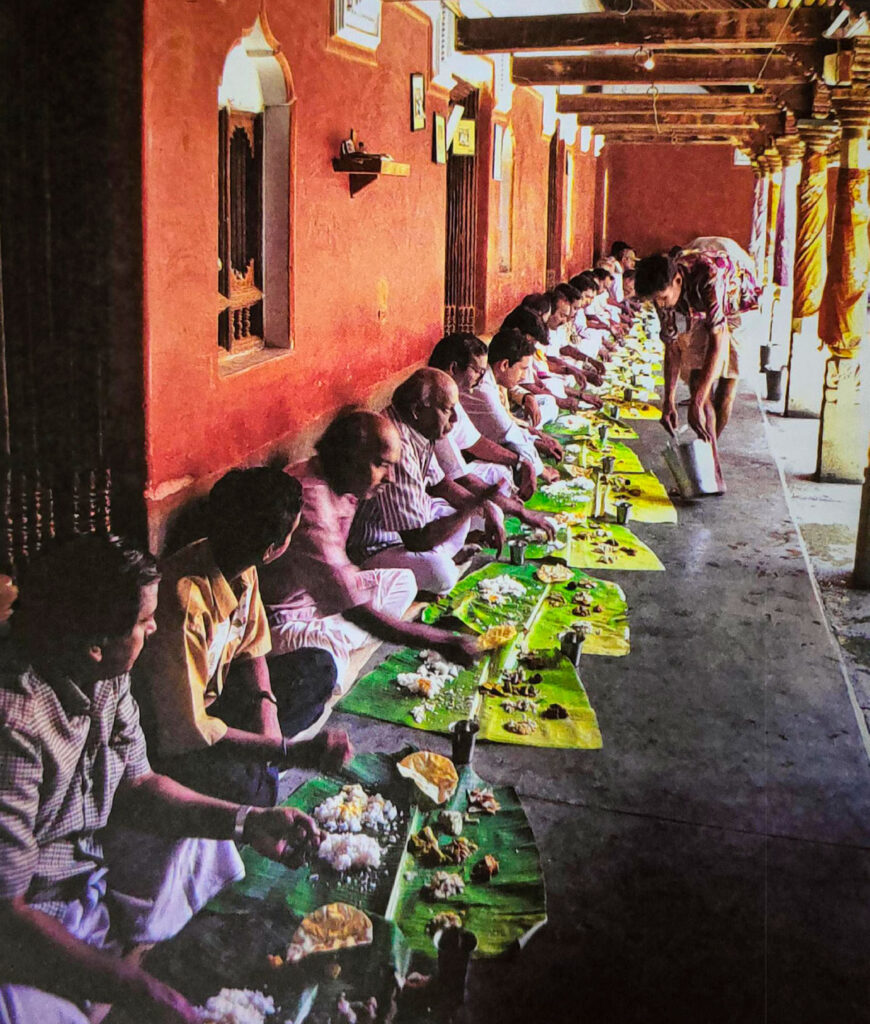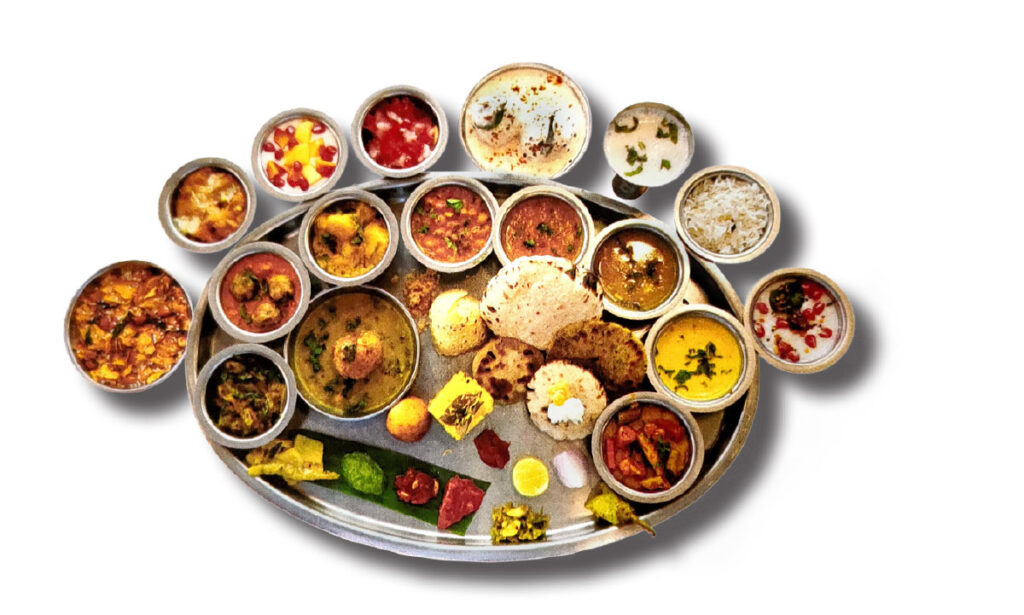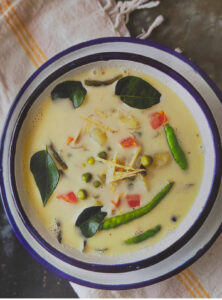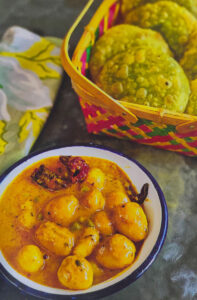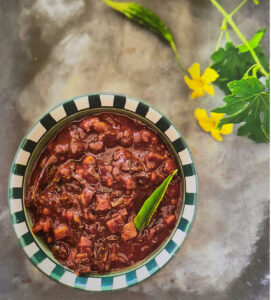Celebrating the diversity of Indian food
If you’ve been to a South Indian wedding or a festival celebration in the south, you would’ve probably seen rows of people sitting cross-legged on the floor — with plantain leaves placed in front of them — patiently waiting for the servers to first place salt on it, followed by various appetising side dishes like poriyal (dry roasted vegetables), kootu (mix of lentils and vegetables), pickle, appalam (papad) and a sweet or two. Next, steamed rice and piping hot sambhar are served. You could either opt for kara kuzhambu (thick, sour gravy), rasam, or moar (buttermilk) for your next serving before savouring the delicious payasam (Indian rice pudding). The South Indian thali gives your palate an unforgettable taste, a melange of tangy, spicy sour, and sweet flavours.
You could say the same thing about the North Indian thali, a big plate with smaller bowls to serve the side dishes. The word thali does not merely translate to a platter but, refers to the way meals are eaten in India; a selection of delicious dishes served together. Whichever part of the country you dine in, the thali is readily available in both vegetarian and non-vegetarian options, as it is an inherent part of India’s dietary culture. This quintessential eating experience, in its most elaborate form, is also a feast for your eyes with its bright, and colourful dishes.
As one of the largest consumers of vegetarian food in the world, Indian communities depend on a large variety of healthy, locally produced vegetables, fruits, nuts, grains and cereals. It is no surprise that we have specific or special food for every occasion, season, festival, age, region and even the day of the week!
The Great Indian Thali by Nandita Iyer, a nutritionist, is where stories meet flavours on a banana leaf or a round platter. Drawing recipes from Indian homes specific to the four main seasons of the country — spring, summer, monsoon and winter — the book shows you how to create 70 easy-to-make, delicious vegetarian recipes from your kitchen. The author takes a practical approach to cooking by using readily available ingredients and techniques that help enhance flavour and save time.
This book is also for those who are tired of preparing and eating the same old aloo (potato), gobi (cauliflower), and bhindi (okra) fry. The wholesome vegetable recipes will give you a culinary tour of India’s landscape, make your mouth water and enlighten you with India’s ayurvedic food history. The tagline “Thali brings India together” sums up the book’s objective to inform and delight the readers with authentic recipes of the subcontinent.
_________________________
Serves 4
Ishtu
Kerala vegetable stew
Cooking time: 30 minutes
Ingredients
- 1 tbsp + 1 tbsp coconut oil
- 2 green cardamoms
- 3 – 4 cloves
- 1 piece cinnamon (1”)
- 5 – 6 black peppercorns
- 20 g ginger, julienned
- 1 sprig curry leaves
- 1 large onion, peeled and sliced
- 1 large carrot, peeled and diced
- 2 medium potatoes, peeled and diced
- ½ cup (60 g) green peas
- 12–14 green beans, julienned
- 1½ tsp salt
- ½ tsp white pepper powder (optional)
- 400 ml coconut milk
- 2 green chillies, slit
Method
- In a pan or a pressure cooker, heat the oil. Add the whole spices and fry for 30 seconds until aromatic.
- Add half the julienned ginger and the curry leaves. Fry until the curry leaves turn bright green.
- Stir in the sliced onions and fry over medium heat for 3 – 4 minutes until it softens a bit.
- Mix in the remaining vegetables and saute for a few seconds. Add in half a cup of water, salt, and white pepper powder. Pressure cook for one whistle on stove top cooker or 10 minutes in electronic pressure cooker (pressure cook mode). Release pressure.
- Add in the coconut milk, green chillies and the remaining ginger. Bring to a gentle simmer. Take the pan off the heat. Add a final layer of flavour with coconut oil and raw curry leaves. Serve hot with plain rice, lacy aapams, or string hoppers.
Note
- Some recipes do not use the whole spices and the flavouring is from ginger, chillies, curry leaves and coconut milk alone. Spices like cardamom, cloves and cinnamon are abundantly grown in Kerala, especially the Malabar region, so it makes sense to use it in the recipe for added flavour. You can by all means make a simpler version of this recipe by avoiding the whole spices.
- This recipe uses a total of 400 grams of chopped vegetables. Mix and match using the fresh vegetables that you have on hand.
_________________________
Makes 10
Motorshutir Kochuri
Deep fried flatbreads stuffed with fresh green peas
Time taken: 50 minutes
The fresh green peas available in winters makes its way into these kochuris that are invariably a part of BengaIi wedding feasts during the season. It is also one of the favourite jolkhabar (a Bengali term for snack) when served with aloor dom (potato curry). A bit of prep the previous night in preparing the dough and the filling makes it a rather easy festive breakfast.
Ingredients
For the dough
- 1 cup (150 g) all-purpose flour with ½ tsp salt
- 1 tsp sugar
- 4 tsp cooking oil
For the filling
- 1 cup (150 g) shelled peas (fresh)
- 3 green chillies
- 2 tsp finely grated ginger
- ½ tsp ground cumin
- ½ tsp salt
- 1 tsp sugar
- 2 tsp oil
- ½ tsp nigella seeds (kalonji)
- 1/8 tsp asafoetida
2 cups oil for deep-frying
Method
- Combine the ingredients for the dough in a bowl. Make sure the oil is well combined into the dough. Add warm water, a little at a time to make a smooth dough. Cover the bowl and allow it to rest for 15 – 30 minutes.
- Meanwhile, prepare the filling. In a saucepan with 2 cups of water, boil the peas for 3 – 4 minutes until soft. Drain well. Combine with chillies, ginger, cumin powder, salt, and sugar and grind to a fine paste without using any extra water.
- Heat 2 tsp oil in a pan. Fry the nigella seeds and asafoetida for a few seconds. Scrape the prepared paste into the oil. Stir it over low-medium heat to dry out the moisture. This is to ensure that filling is not soggy. Keep stirring until the mixture comes together into a ball. Remove into a dish and let it cool.
- Divide the dough and the filling into 10 portions each. Flatten out the dough and make it into a cup in your palm. Add in the filling and cover well and roll into a ball. Using an oiled rolling pin and base, roll out into thick puris 5” diameter size.
- Heat oil in a wok and deep-fry each such kochuri separately over high heat until it puffs up. Flip it over with a slotted spoon and fry the other side for 20–30 seconds as well.
- Drain on a kitchen paper to absorb the excess oil.
- Serve with aloor dom (baby potatoes in Bengali style curry).
_________________________
Serves 4
Bitter gourd curry
Time taken: 50 minutes
Gojju is a spicy, tangy and sweet preparation from Karnataka, typically had with steamed rice and ghee. It is prepared with a variety of vegetables and even fruits like pineapple and grapes. If you are a fan of salty-sweet flavours in a dish, this one is a must try.
Ingredients
- 3 – 4 medium sized (225 g) bitter gourds
- 2 cups chopped (karela)
- ¼ cup (40 g) tamarind + 2 cups water
- 2 tbsp peanut oil
- 1 tsp black mustard seeds
- 1 tsp split skinned urad dal
- ½ tsp ground turmeric
- 2 sprigs curry leaves
- 2 tsp salt
- 2 tsp rasam powder
- Kashmiri red chilli powder to taste
- ¼ cup (50 g) crushed jaggery
Method
- Slice the bitter gourds vertically. Remove seeds and inner white pith and dice it finely.
- Soak the tamarind in water for 20 minutes. Squeeze the soaked tamarind to extract the pulp. Discard the squeezed tamarind pieces and keep the extract aside.
- In a pan, heat the oil. Fry mustard seeds until they start popping. Add in the urad dal and fry over medium heat until golden brown in colour.
- To this, combine the chopped bitter gourd and fry over low to medium heat for 15 minutes. This will change colour to a duller green and the bitter gourd gets partially cooked. Sprinkle turmeric and stir in curry leaves. Stir well to combine and cook for another 5 minutes.
- At this point, pour the tamarind extract along with ½ cup of boiling hot water and let it come to a simmer over high heat. Allow to boil for 5 – 7 minutes and the tamarind extract to thicken. Add salt, rasam powder, chilli powder, and powdered jaggery. Allow the ‘gojju’ to boil for another 2 – 3 minutes. The consistency of the gojju is much thicker than dal so make sure you don’t add too much water.
- You can try the same recipe using sliced okra or green grapes.
Note
- The colour of the gojju depends on the tamarind used. A darker aged variety of tamarind will give a dark brown gojju.
- Acidity varies depending on tamarind, so taste as you go to balance chilli, jaggery, and salt.
- 1 tbsp coarsely powdered white sesame seeds can be added in the final stage.

